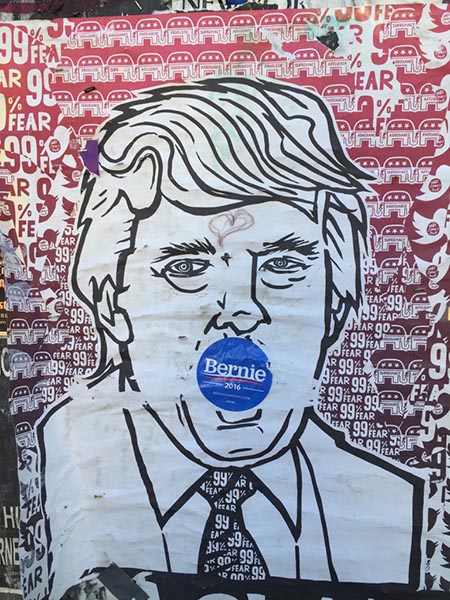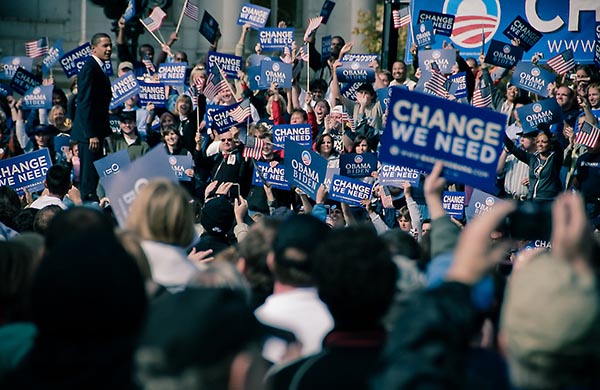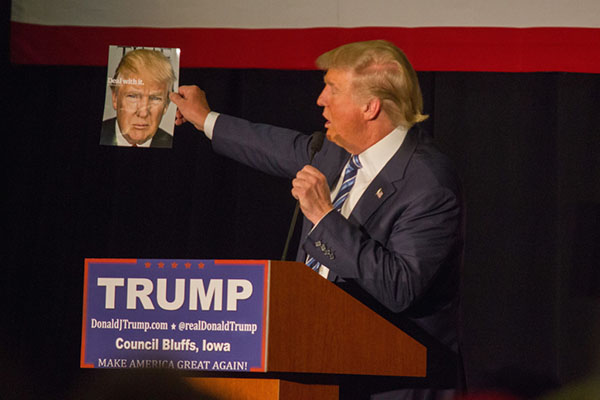Editor’s note: This post was written prior to the New York state primary on Tuesday, April 19, in which Hillary Clinton and Donald Trump both won majorities.
Against all pundits’ bets, Donald Trump and Bernie Sanders each stand a chance of winning their parties’ nominations. Writing in disbelief, media analysts and scholars have attempted to explain the allure of both candidates to the disenchanted masses. Some write about the widening gap between the wealthy and the poor, and the increasing disconnect between party elites and their constituents to explain the rise of political outsiders; others write about racial backlash against President Obama. And still others write about how years of merciless and cynical political manipulation within the parties has polarized political discourse in the U.S. “Populism!” analysts decry, Peron-style banana republic populism, has taken over U.S. electoral politics.
But where should we draw the line between populism and campaigning for a presidential election more generally? Many scholars in anthropology and media studies (especially those from the so-called “banana republics”) have pointed out that populism is a slippery analytical category that can mean many things, and that lends itself to many ideological projects (Mazzoleni, Stewart, and Horsfield 2003). For example, Ernesto Laclau (2005) sharply observes that populism is a rationale, a way of crafting public discourse based on a “us versus them” logic built upon a “chain of equivalences.” What Laclau means is that populist discourse ties together disparate social claims under a single message, and through this, the populist leader crafts a public identity that resonates with many types of social and political groups that have very different kinds of grievances. In this process, the leader embodies an aggregate version of “the people” based on the lowest common denominator, like national belonging.

BernieTrump. Source: Juliusbulius. Licensed for reuse under CC BY-NC-SA 2.0.
In light of Laclau’s definition of populism, both Donald Trump and Bernie Sanders have resorted to populist devices. In a recent post, Kaushik Sunder Rajan reminds us that Trump and Sanders are two sides of the same coin. Both candidates have touched on widespread economic anxieties that include the widening economic gap, the loss of jobs, and a sense of economic insecurity both in rural areas and in cities. However, each candidate has crafted the “chain of equivalences” in different ways. While Trump has tied economic anxieties to anti-immigrant, xenophobic, and misogynistic sentiments, Sanders resorts to middle-class nostalgia to the same effect.
Yet Trump and Sanders are not unique, neither in the context of this election nor of past ones. Because it depends on winning over majorities, electoral politics (and especially presidential elections), is inherently populist. Any candidate running in a presidential election flirts with populism. For example, how is Trump’s vague “Make America Great Again” more or less populist than President Reagan’s original “Let’s Make America Great Again,” President Bush’s “A Safer World and a More Hopeful America,” or President Obama’s 2008 ethereal message of “Change”? What were media experts talking about, if not a lack of populism, when they critiqued Hillary Clinton for not being “authentic” and “exciting” enough, and therefore not being a strong candidate?

Change is Coming. By Chris Coleman, CC BY-NC-ND 2.0.
Professionally Managed Populism
I study the rise of professionally managed elections and the influence of American-style political marketing in Colombian politics. In looking at American electoral politics through the work of American consultants in Colombia, I have learned that populism and political marketing share much in common. American-style political campaigning encompasses a series of standardized techniques to objectively understand voters’ emotional attachments and their symbolic worlds. The aim of these techniques is to exploit popular sentiments and “native” divisive social issues to galvanize voters and win elections.
Just like a populist leader, political marketing seeks to put the right amount of pressure on the neuralgic points that will move voters to go to the polls. This is a game of majorities and strategies, of casting a wide-enough net as to seduce as many uncommitted voters as possible. Political marketers rely on principles of commercial marketing to do so. And commercial marketing relies on a similar operation as populism: it is based on arbitrarily attaching meanings to products that have nothing to do with the product in the first place (Applbaum 2004). Like marketing the Mini Cooper to yoga lovers.
But unlike commercial marketing, presidential candidates need to inspire voters beyond particular niches. Their challenge is the equivalent of selling a Mini Cooper to a monster truck fan. To do so, candidates have to perform a difficult balancing act. On the one hand, they have to craft a wide enough message that will appeal to many types of potential supporters. On the other hand, they have to stay on message as to establish an identity, a recognizable brand. Candidates have to galvanize without alienating, and excite with their authenticity.
This particular challenge of selling to the majority yet appearing unique lends itself to the appearance of populist messages aimed at creating identification between the candidate and the lived experiences of a majority of people. For this purpose, campaigns will craft messages broad enough that they can captivate different types of voters, but narrow enough to be credible. Political consultants accomplish this acrobatics by “styling” the message of a campaign. Consultants will advise candidates how to speak about issues in a way that is coherent with the public’s perceptions of the candidate (measured through traditional polling methods), and also with the candidate’s personality.
Trump, as a savvy showman, and Sanders, as a savvy senator, know how to play this game. Going rogue on professional campaigning, Trump knows that shock and vulgarity sell, and that they will get him free media exposure. Treating elections akin to reality TV and personal branding (both fields in which he has been quite successful), Trump shows that what matters in electoral politics is the style of the performance (appearing strong, resolute, and being entertaining), and not the content of his discourse. Sanders shows that encapsulating America’s economic anxieties in a simple, understandable and straightforward message works.

Donald Trump. By Matt Johnson, CC BY-NC 2.0.
If all campaigns are populist, what are we really talking about when we use the label? The media’s characterization of Trump and Sanders as populists seems to be shorthand to call political outsiders whose communication styles deviate from dominant, “acceptable” communication formats. Critics of both Trump and Sanders see their populism stemming from their misunderstanding of policy issues that reflects in unrealistic, and demagogic campaign proposals that appeal to (negative) emotions and not to reason. In Trump’s case, we use “populist” for the grotesque exploitation of racism, xenophobia, and misogyny to gain an electoral advantage at all cost (for example, his insistence on building a wall along the border with Mexico, and banning Muslims from entering the United States), and for the vulgar, folk delivery of these divisive messages. In Sanders’ case, we use “populist” for a socialist rhetoric that runs contrary to America’s originalist economic fantasies–specifically, Sanders’ promise to regulate Wall Street and break up big banks.
I find problematic the usage of the label “populist” to describe both candidates because it encompasses an “us vs. them” logic similar to the one animating demagogic discourses. More than explaining the political dynamics at work in Sanders’ and Trump’s political universes (which are very different), the usage of the label “populism” draws a stark opposition between expert consensus—those enlightened ones who really understand what’s going on—and the gullible masses. I wonder to what extent the media’s usage of the label populism contributes to the emergence of a rhetorical space where power insiders can recast themselves as political outsiders, and exploit this identity to their advantage.
References
Applbaum, Kalman. 2004. The Marketing Era: From Professional Practice to Global Provisioning. New York: Routledge.
Laclau, Ernesto. 2005. On Populist Reason. New York: Verso.
Mazzoleni, Gianpietro, Julianne Stewart, and Bruce Horsfield. 2003. The Media and Neo-Populism: A Contemporary Comparative Analysis. Greenwood Publishing Group.

1 Trackback